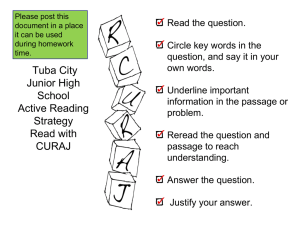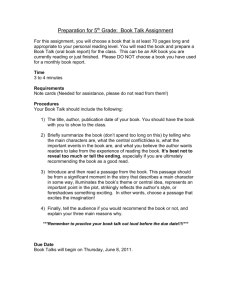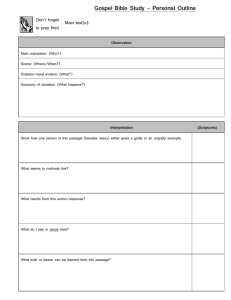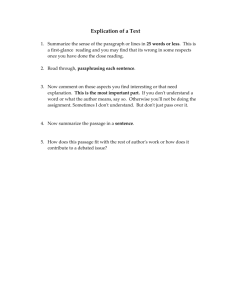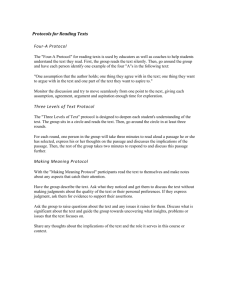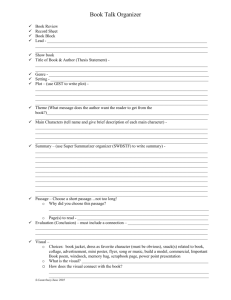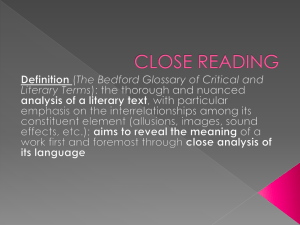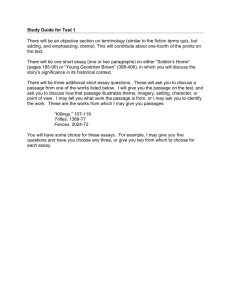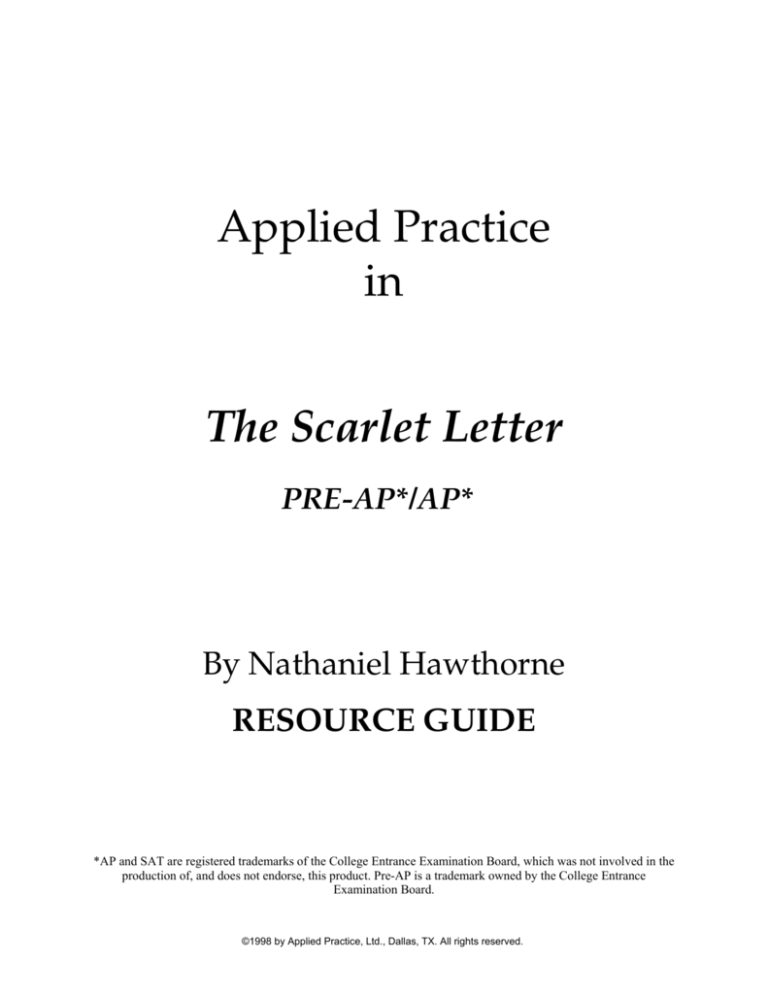
Applied Practice in The Scarlet Letter PRE-AP*/AP*
By Nathaniel Hawthorne RESOURCE GUIDE *AP and SAT are registered trademarks of the College Entrance Examination Board, which was not involved in the
production of, and does not endorse, this product. Pre-AP is a trademark owned by the College Entrance
Examination Board.
©1998 by Applied Practice, Ltd., Dallas, TX. All rights reserved.
APPLIED PRACTICE
Resource Guide
The Scarlet Letter
Pre-AP*/AP* Version
Teacher Notes
A Note for Teachers .............................................................. 2
Teaching Resources
Strategies for Multiple-Choice Questions............................. 4
Strategies for Free-Response Questions ............................... 5
Glossary of Literary Terms ................................................... 6
Vocabulary Lists by Passage............................................... 14
Student Practices
Multiple-Choice Questions ................................................. 18
Free-Response Questions .................................................... 45
Answer Key and Explanations
Multiple-Choice Answer Key ............................................. 52
Multiple-Choice Answer Explanations............................... 54
Free-Response Scoring Guide............................................. 67
*Pre-AP and AP are registered trademarks of the College Entrance Examination Board, which was not involved in the production of,
and does not endorse, this product.
©1998 by Applied Practice, Ltd., Dallas, TX. All rights reserved.
GLOSSARY OF LITERARY TERMS
absolute—a word free from limitations or qualifications (“best,” “all,” “unique,”
“perfect”)
adage—a familiar proverb or wise saying
ad hominem argument—an argument attacking an individual’s character rather than his
or her position on an issue
allegory—a literary work in which characters, objects, or actions represent abstractions
alliteration—the repetition of initial sounds in successive or neighboring words
allusion—a reference to something literary, mythological, or historical that the author
assumes the reader will recognize
analogy—a comparison of two different things that are similar in some way
anaphora—the repetition of words or phrases at the beginning of consecutive lines or
sentences
anecdote—a brief narrative that focuses on a particular incident or event
antecedent—the word, phrase, or clause to which a pronoun refers
antithesis—a statement in which two opposing ideas are balanced
aphorism—a concise statement that expresses succinctly a general truth or idea, often
using rhyme or balance
apostrophe—a figure of speech in which one directly addresses an absent or imaginary
person, or some abstraction
archetype—a detail, image, or character type that occurs frequently in literature and myth
and is thought to appeal in a universal way to the unconscious and to evoke a
response
argument—a statement of the meaning or main point of a literary work
asyndeton—a construction in which elements are presented in a series without
conjunctions
©1998 by Applied Practice, Ltd., Dallas, TX. All rights reserved.
6
VOCABULARY LIST FOR THE SCARLET LETTER
Note: Vocabulary from the literary passage is listed first, followed by vocabulary from
the questions and answers.
Passage 1
Passage 2
Passage 3
intently
rigidity
petrified
augured
severity
indubitably
scourged
solemnity
interfused
rotundity
winced
heathenish
adornment
discerning
disarray
furrowed
visage
heterogeneous
garb
deformity
penetrative
writhing
instantaneously
grievous
redeemed
sojourn
iniquity
expound
ignominious
irks
morbid
infamy
annihilate
ignominy
vivify
embody
obscure
inscrutable
assimilate
ignominy
assimilations
strove
purge
martyrdom
_______________
culprit
deficiencies
virtuous
_____________
_______________
posit
chronicler
ambivalence
ironic
bemuse
unwavering
©1998 by Applied Practice, Ltd., Dallas, TX. All rights reserved.
14
Directions: This part consists of selections from The Scarlet Letter and questions on their content, form, and
style. After reading each passage, choose the best answer to each question.
Note: Pay particular attention to the requirement of questions that contain the words NOT, LEAST, or
EXCEPT.
Passage 1, Questions 1-7. Read the following passage from Chapter 1, “The Market-Place,” carefully before
you choose your answers.
5
10
15
20
25
30
35
40
45
The grass-plot before the jail, in Prison
Lane, on a certain summer morning, not less than
two centuries ago, was occupied by a pretty large
number of the inhabitants of Boston, all with their
eyes intently fastened on the iron-clamped oaken
door. Amongst any other population, or at a later
period in the history of New England, the grim
rigidity that petrified the bearded physiognomies of
these good people would have augured some awful
business in hand. It could have betokened nothing
short of the anticipated execution of some noted
culprit, on whom the sentence of a legal tribunal
had but confirmed the verdict of public sentiment.
But, in that early severity of the Puritan character,
an inference of this kind could not so indubitably
be drawn. It might be that a sluggish bond-servant,
or an undutiful child, whom his parents had given
over to the civil authority, was to be corrected at the
whipping-post. It might be, that an Antinomian, a
Quaker, or other heterodox religionist was to be
scourged out of the town, or an idle and vagrant
Indian, whom the white man’s fire-water had made
riotous about the streets, was to be driven with
stripes into the shadow of the forest. It might be,
too, that a witch, like old Mistress Hibbins, the
bitter-tempered widow of the magistrate, was to die
upon the gallows. In either case, there was very
much the same solemnity of demeanor on the part
of the spectators; as befitted a people amongst
whom religion and law were almost identical, and
in whose character both were so thoroughly
interfused, that the mildest and the severest acts of
public discipline were alike made venerable and
awful. Meagre, indeed, and cold was the sympathy
that a transgressor might look for from such bystanders, at the scaffold. On the other hand, a
penalty, which, in our days, would infer a degree of
mocking infamy and ridicule, might then be
invested with almost as stern a dignity as the
punishment of death itself.
It was a circumstance to be noted, on the
summer morning when our story begins its course,
that the women, of whom there were several in the
crowd, appeared to take a particular interest in
whatever penal infliction might be expected to
ensue. The age had not so much refinement, that
any sense of impropriety restrained the wearers of
50
55
60
65
70
75
80
85
90
petticoats and farthingale from stepping forth into
the public ways, and wedging their not
unsubstantial persons, if occasion were, into the
throng nearest to the scaffold at an execution.
Morally, as well as materially, there was a coarser
fibre in those wives and maidens of old English
birth and breeding, than in their fair descendants,
separated from them by a series of six or seven
generations; for, throughout that chain of ancestry,
every successive mother has transmitted to her
child a fainter bloom, a more delicate and briefer
beauty, and a slighter physical frame, if not a
character of less force and solidity, than her own.
The women who were now standing about the
prison-door stood within less than half a century of
the period when the man-like Elizabeth had been
the not altogether unsuitable representative of the
sex. They were her country-women; and the beef
and ale of their native land, with a moral diet not a
whit more refined, entered largely into their
composition. The bright morning sun, therefore,
shone on broad shoulders and well-developed
busts, and on round and ruddy cheeks, that had
ripened in the far-off island, and had hardly yet
grown paler or thinner in the atmosphere of New
England. There was, moreover, a boldness and
rotundity of speech among these matrons, as most
of them seemed to be, that would startle us at the
present day, whether in respect to its purport or its
volume of tone.
“Goodwives,” said a hard-featured dame
of fifty, “I’ll tell ye a piece of my mind. It would
be greatly for the public behoof, if we women,
being of mature age and church-members in good
repute, should have the handling of such
malefactresses as this Hester Prynne. What think
ye, gossips? If the hussy stood up for judgment
before us five, that are now here in a knot together,
would she come off with such a sentence as the
worshipful magistrates have awarded? Marry, I
trow not!”
“People say,” said another, “that the
Reverend Master Dimmesdale, her godly pastor,
takes it very grievously to heart that such a scandal
should have come upon his congregation.”
“The magistrates are God-fearing
gentlemen, but merciful overmuch --that is a truth,”
©1998 by Applied Practice, Ltd., Dallas, TX. All rights reserved.
19
95 added a third autumnal matron. “At the very least,
they should have put the brand of a hot iron on
Hester Prynne’s forehead. Madam Hester would
have winced at that, I warrant me. But she--the
naughty baggage--little will she care what they put
100 upon the bodice of her gown! Why, look you, she
may cover it with a brooch, or such like heathenish
adornment, and so walk the streets as brave as
ever!”
“Ah, but,” interposed, more softly, a
105 young wife, holding a child by the hand, “let her
cover the mark as she will, the pang of it will be
always in her heart.”
“What do we talk of marks and brands,
whether on the bodice of her gown, or the flesh of
110 her forehead?” cried another female, the ugliest as
well as the most pitiless of these self-constituted
judges. “This woman has brought shame upon us
all, and ought to die. Is there not law for it? Truly,
there is, both in the Scripture and the statute-book.
115 Then let the magistrates, who have made it of no
effect, thank themselves if their own wives and
daughters go astray!”
“Mercy on us, goodwife,” exclaimed a
man in the crowd, “is there no virtue in woman,
120 save what springs from a wholesome fear of the
gallows? That is the hardest word yet! Hush, now,
gossips! for the lock is turning in the prison-door,
and here comes Mistress Prynne herself.”
3.
(A)
(B)
(C)
(D)
(E)
4.
5.
hyperbole
parallel construction
metaphor
syllogistic reasoning
allegory
The negative tone of the speaker’s appraisal of
the assembled women is tempered by which of
the following phrases?
(A) “wedging their not insubstantial
persons” (lines 49-50)
(B) “a coarser fibre in those wives and
maidens” (lines 52-53)
(C) “a more delicate and briefer beauty”
(lines 58-59)
(D) “with a moral diet not a whit more
refined” (lines 66-67)
(E) “in respect to its purport or its volume of
tone” (lines 76-77)
The narrator seems to feel that the women of
the era
The conversation beginning “Goodwives” (line
(78) and ending “ . . . Mistress Prynne herself”
(line 123) is characterized by several
(A)
(B)
(C)
(D)
(E)
7.
2.
purpose
appearance
meaning
transport
allegation
(A) are harsher in their judgments than are the
ruling men
(B) are overly subservient to men
(C) are without exception bitter-tempered
(D) are more refined than the “man-like”
Elizabeth”
(E) are concerned about Antinomians
A prominent stylistic characteristic of the
narrator’s discussion of the awaited culprit’s
possible identity: “But in that early . . .
made venerable and awful” (lines 14-34) is
(A)
(B)
(C)
(D)
(E)
“speech” (line 74)
“matrons” (line 74)
“them” (line 75)
“present day” (line 76)
“respect” (line 76)
As used in line 76, “purport” means
(A)
(B)
(C)
(D)
(E)
6.
1.
The antecedent of “its” in line 76 is
personifications
euphemisms
apostrophes
antitheses
rhetorical questions
The words of the man in the crowd, “Mercy on
us . . . hardest word yet!” (lines 118-121) serve
the purpose of
(A) pointing out the moral deficiencies of the
women of the era
(B) explaining the magistrates’ choice of
Hester’s sentence
(C) exposing the underlying implication of
the “goodwife’s” words
(D) criticizing those who would question
authority
(E) comparing virtuous women to those who
fear the gallows
©1998 by Applied Practice, Ltd., Dallas, TX. All rights reserved.
20
Question 1
(Suggested time--40 minutes)
In the following passage from The Scarlet Letter, the narrator introduces the reader to the Puritan community of
the novel. Read the passage carefully. Then write an essay analyzing how the narrator’s description of the
Puritans and their community suggests his attitude toward them. You might consider such elements as selection
of detail, manipulation of language, and tone.
5
10
15
20
25
30
35
40
45
The grass-plot before the jail, in Prison
Lane, on a certain summer morning, not less than
two centuries ago, was occupied by a pretty large
number of the inhabitants of Boston, all with their
eyes intently fastened on the iron-clamped oaken
door. Amongst any other population, or at a later
period in the history of New England, the grim
rigidity that petrified the bearded physiognomies of
these good people would have augured some awful
business in hand. It could have betokened nothing
short of the anticipated execution of some noted
culprit, on whom the sentence of a legal tribunal
had but confirmed the verdict of public sentiment.
But, in that early severity of the Puritan character,
an inference of this kind could not so indubitably
be drawn. It might be that a sluggish bond-servant,
or an undutiful child, whom his parents had given
over to the civil authority, was to be corrected at the
whipping-post. It might be, that an Antinomian, a
Quaker, or other heterodox religionist was to be
scourged out of the town, or an idle and vagrant
Indian, whom the white man’s fire-water had made
riotous about the streets, was to be driven with
stripes into the shadow of the forest. It might be,
too, that a witch, like old Mistress Hibbins, the
bitter-tempered widow of the magistrate, was to die
upon the gallows. In either case, there was very
much the same solemnity of demeanor on the part
of the spectators; as befitted a people amongst
whom religion and law were almost identical, and
in whose character both were so thoroughly
interfused, that the mildest and the severest acts of
public discipline were alike made venerable and
awful. Meagre, indeed, and cold was the sympathy
that a transgressor might look for from such bystanders, at the scaffold. On the other hand, a
penalty, which, in our days, would infer a degree of
mocking infamy and ridicule, might then be
invested with almost as stern a dignity as the
punishment of death itself.
It was a circumstance to be noted, on the
summer morning when our story begins its course,
that the women, of whom there were several in the
crowd, appeared to take a particular interest in
whatever penal infliction might be expected to
ensue. The age had not so much refinement, that
any sense of impropriety restrained the wearers of
50
55
60
65
70
75
petticoats and farthingale from stepping forth into
the public ways, and wedging their not
unsubstantial persons, if occasion were, into the
throng nearest to the scaffold at an execution.
Morally, as well as materially, there was a coarser
fibre in those wives and maidens of old English
birth and breeding, than in their fair descendants,
separated from them by a series of six or seven
generations; for, throughout that chain of ancestry,
every successive mother has transmitted to her
child a fainter bloom, a more delicate and briefer
beauty, and a slighter physical frame, if not a
character of less force and solidity, than her own.
The women who were now standing about the
prison-door stood within less than half a century of
the period when the man-like Elizabeth had been
the not altogether unsuitable representative of the
sex. They were her country-women; and the beef
and ale of their native land, with a moral diet not a
whit more refined, entered largely into their
composition. The bright morning sun, therefore,
shone on broad shoulders and well-developed
busts, and on round and ruddy cheeks, that had
ripened in the far-off island, and had hardly yet
grown paler or thinner in the atmosphere of New
England. There was, moreover, a boldness and
rotundity of speech among these matrons, as most
of them seemed to be, that would startle us at the
present day, whether in respect to its purport or its
volume of tone.
©1998 by Applied Practice, Ltd., Dallas, TX. All rights reserved.
46

